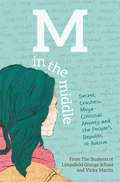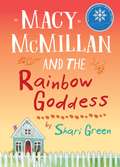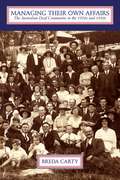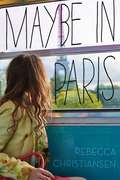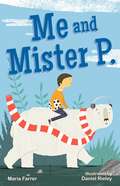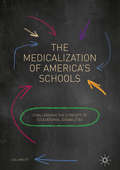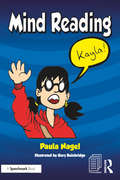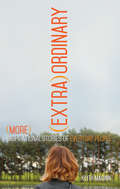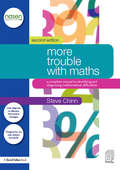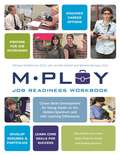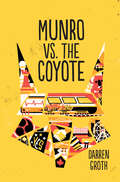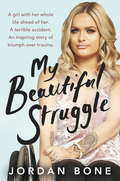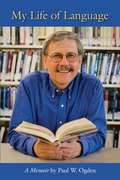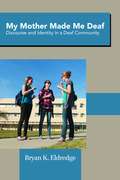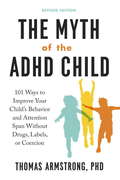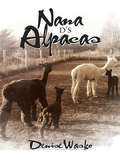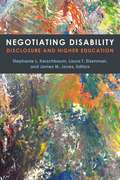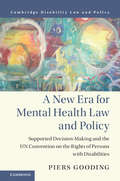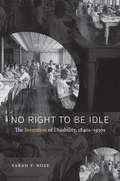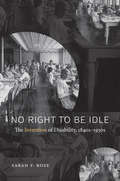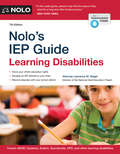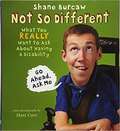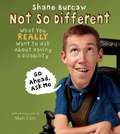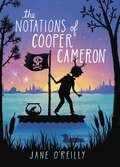- Table View
- List View
M in the Middle: Secret Crushes, Mega-Colossal Anxiety and the People’s Republic of Autism
by Vicky Martin The Students of Limpsfield Grange SchoolI'll never have a Card Emporium series of life events: a boyfriend, a fiancé, a husband and a future. A future with lots of sparkly cards celebrating all these big life events. I was on course and now I'm not. Life after diagnosis isn't easy for M. Back in her wobbly world, there are lots of changes and ups and downs to get used to, not just for M, but for her friends and family too. Faced with an exciting crush, a pushy friend and an unhelpful Headteacher, how long until the beast of anxiety pounces again? Written by Vicky Martin and the students of Limpsfield Grange, a school for girls with Autism Spectrum Disorder and communication and interaction difficulties, M's story draws on the real life experiences of teens with autism.
Macy Mcmillan and the Rainbow Goddess
by Shari GreenWinner of the 2018 ALA Schneider Family Middle School Books Award. Sixth grade is coming to an end, and so is life as Macy McMillan knows it. Already a "For Sale" sign mars the front lawn of her beloved house. Soon her mother will upend their perfect little family, adding a stepfather and six-year-old twin stepsisters. To add insult to injury, what is Macy's final sixth grade assignment? A genealogy project. Well, she'll put it off - just like those wedding centerpieces she's supposed to be making.Just when Macy's mother ought to be understanding, she sends Macy next door to help eighty six-year-old Iris Gillan, who is also getting ready to move - in her case into an assisted living facility. Iris can't pack a single box on her own and, worse, she doesn't know sign language. How is Macy supposed to understand her? But Iris has stories to tell, and she isn't going to let Macy's deafness stop her. Soon, through notes and books and cookies, a friendship grows. And this friendship, odd and unexpected, may be just what Macy needs to face the changes in her life. Shari Green, author of Root Beer Candy and Other Miracles, writes this summer story with the lightest touch, spinning Macy out of her old story and into a new one full of warmth and promise for the future.
Managing Their Own Affairs: The Australian Deaf Community In The 1920s And 1930s
by Breda CartyManaging Their Own Affairs explores how Deaf organizations and institutions were forged in Australia during the early 20th century. During this period, deaf people challenged the authority of the dominant welfare organizations, or Deaf Societies, which were largely controlled by hearing people and run as charitable institutions. Breda Carty comprehensively documents the growth of the Australian Deaf community and Australian Deaf organizations for the first time. She focuses on both the political developments of the early 20th century and on the nature of the relationships between deaf and hearing people. During this time, deaf Australians aspired to manage their own affairs. They enjoyed some success by establishing “breakaways” from the Deaf Societies, and they also established an independent national organization, which was contested and ultimately suppressed by the Deaf Societies. These developments were influenced by wider social movements in Australian society, such as the mobilization of minority groups in their push for autonomy and equal rights. Although most of the breakaway Deaf organizations did not survive beyond the 1930s, they significantly affected the power structures and relationships between deaf and hearing people in Australia. The Australian Deaf community’s attempts to organize independently during these years have been largely erased from collective memory, making Carty’s examination a particularly important and necessary addition to the historical literature.
Maybe in Paris
by Rebecca ChristiansenKeira Braidwood lands in Paris with her autistic brother, Levi, and high hopes. Levi has just survived a suicide attempt and months in the psych ward-he’s ready for a dose of the wider world. Unlike their helicopter mom and the doctors who hover over Levi, Keira doesn’t think Levi’s certifiable. He’s just . . . quirky. Always has been.Those quirks quickly begin to spoil the trip. Keira wants to traipse all over Europe; Levi barely wants to leave their grubby hotel room. She wants to dine on the world’s cuisine; he only wants fast food. Levi is one giant temper tantrum, and Keira’s ready to pull out her own hair.She finally finds the adventure she craves in Gable, a hot Scottish bass player, but while Keira flirts in the Paris Catacombs, Levi’s mental health breaks. He disappears from their hotel room and Keira realizes, too late, that her brother is sicker than she was willing to believe. To bring him home safe, Keira must tear down the wall that Levi’s sickness and her own guilt have built between them.
Me and Mister P.: Me And Mister P. , Book Two (Me and Mister P. #2)
by Maria Farrer Daniel RieleyMister P. is the coolest friend a kid could wish for!Arthur is fed up with his younger brother Liam getting all the attention from their parents just because he's a little bit different from other kids. Arthur just wants a normal family and a normal life, where he can play soccer and hang out with friends -- without Liam always being so embarrassing. Just when Arthur can't take it anymore, Mister P. -- a polar bear with a suitcase -- shows up. He doesn't talk, and Arthur is scared of him at first. (He is a polar bear, after all!) But he isn't dangerous. In fact, Mister P. is lots of fun, and even gets along with Liam. He comes with Arthur to school and soccer, and makes life an adventure! Still, Mister P. can't stay forever. But before he goes, he helps as only a polar bear can... leading Arthur to see his brother in a whole new way.
The Medicalization of America's Schools
by Joel MachtThis book challenges the validity of ADHD, learning disabilities, and dyslexia as meaningful special education "categories" and critically examines the misplaced medical model from which they are derived. The presumption that these disabilities cause school-related problems detracts from identifying factors within the classroom that create and maintain a child's underachievement and disruptive behavior. Moreover, when the disability is finally named, it provides no functional information that translates into effective coping strategies. Macht delves into the misunderstood structure of these disabilities, pointing out that they are not verifiable disabilities but weak constructs that poorly describe each child's uniqueness. Finally, he provides an alternative model based on children's strengths rather than their deficiencies, and presents strategies that advance school-related success.
Mind Reading: But What If...; Mind Reading; Stuck On A Loop; Waht Is It? (Rollercoaster Series)
by Paula NagelThis is a focus on feelings of social isolation and unhelpful thinking habits linked to friendship difficulties. Stacie wonders why her best friend, Kayla, ignores her when she sees her in town at the weekend. All weekend she thinks about the possible reasons, and imagines some of the negative things Kayla might be saying or thinking about her. By Monday morning, she has convinced herself they are true, and that Kayla no longer wants to be her friend. She avoids Kayla at school, which causes further problems. At break time Stacie sees Kayla with another group of girls and imagines they are talking about her. At the end of the day Kayla catches up with Stacie and asks her if she has done something wrong. Stacie says she knows Kayla no longer wants to be her friend because she ignored her in town. Kayla explains she had just been fitted with her new contact lenses and didn't even see her! Stacie is shocked and confesses how she imagined she knew what Kayla was thinking and saying about her. Kayla laughs and they joke about Stacie being a very poor 'mind reader'. Stacie agrees that if she catches herself mind reading again then she will test out her thoughts by talking about them. The accompanying, 'Let's talk about.mind reading,' highlights this common thinking error, and suggests further coping strategies. Paul Nagel has worked as an educational psychologist for 17 years. This has included working as a Lead Professional Educational Psychologist managing a traded service, as well as holding Senior Specialist posts for early years and disability. Over the years Paula has worked in multi agency teams within paediatric services, youth offending teams, Sure Start and an anti bullying service. She is currently Principal Educational Psychologist (North) for the national children's mental health charity, Place2Be. Before qualifying as an Educational Psychologist Paula was a primary school teacher. Gary Bainbridge is an artist, comics creator and secondary school Art, Photography and Media Studies teacher from Durham. He's best known for the North East based kitchen sink superhero comic Sugar Glider and the Newcastle-set crime fiction comic, Nightbus. Gary teaches at an academy in Northumberland.
**Missing**: More Inspirational Stories of Everyday People ((Extra)Ordinary #2)
by Keith Maginn“This world needs books like these right now—the inspirational people within these pages.” - Kimberly Morand, blogger"When everything in life goes wrong, what keeps people going? This wonderful collection of answers tells how some conquered the near impossible." - Frank Litsky, retired editor and reporter, The New York TimesBurned on 100 percent of his body as a young boy, John O’Leary was given a 1 percent chance of survival. Thirty years later, he is a bestselling author, nationally known speaker, beloved husband, and dedicated father.Once controlled by addiction, Todd Crandell is now an addiction counselor—and a world-class Ironman triathlete.Born with no arms or legs, Nick Vujicic fought back from the brink of suicide to become a faith-driven motivational speaker admired by people around the world.These are just three of the inspiring lives featured in (Extra)Ordinary: More Inspirational Stories of Everyday People—tales of individuals who started out as “ordinary” but have proven to be anything but.Each of the people featured in (Extra)Ordinary reminds us of the depth of human potential and calls us to find our own strength to make our mark on the world around us. (Extra)Ordinary opens our eyes to the power that rests in each and every person!"I love this book. If you are looking for a book to inspire you, get yourself a copy. You will not be disappointed." - J. Bronder Book Reviews
More Trouble with Maths: A Complete Manual to Identifying and Diagnosing Mathematical Difficulties (nasen spotlight)
by Steve ChinnMore Trouble with Maths acknowledges that there are many reasons why children and adults are unable to function mathematically. Difficulties include problems with rote learning basic facts and procedures, debilitating anxiety, poor working and short-term memories and mathematics vocabulary. Central to this new edition is a range of standardised tests and diagnostic activities, including a 15 minute test of basic mathematics, a thinking style test, tests of basic fact retrieval and maths anxiety. Guiding the reader in the interpretation of tests, this new edition shows how identifying the barriers to learning is the first step in a programme of intervention. Written in an engaging and user-friendly style, Steve Chinn draws on his extensive experience and expertise to: show how to consider and appraise the many factors relating to mathematical learning difficulties explain how these factors can be investigated explore their impact on learning mathematics. Emphasising the need for a clinical approach when assessing individuals, this book shows how diagnosis and assessment can become integrated into everyday teaching. This highly practical and relevant resource is a crucial resource for anyone who wants to accurately and effectively identify the depth and nature of mathematical learning difficulties and dyscalculia.
Mploy – A Job Readiness Workbook: Career Skills Development for Young Adults on the Autism Spectrum and with Learning Difficulties
by Michael P. Mcmanmon Carol Gray Michele Ramsay Jennifer KolarikThis self-guided workbook is suitable for young adults aged 16-26 with ASD (Autism Spectrum Disorder) or LD (Learning Differences), to teach the necessary skills for entering the workforce and forging a meaningful career path. Providing insight into a range of industries and workplace settings, this workbook will help you to support young people in choosing rewarding and successful careers. Detailing the College Internship Program's (CIP) successful Mploy program, the information in this book will help young adults to develop self-confidence and build social connections. Including activities and ready-to-use worksheets, this is a focused look at preparing for work. Key topics include: · Career assessments · Creating effective resumes/CVs · Interview skills · Employer expectations · Professional communication · Performance appraisals · Handling stress in the workplace · Social thinking · Executive functions in the workplace
Munro vs. the Coyote
by Darren GrothSince the sudden death of his younger sister, Evie, sixteen-year-old Munro Maddux has been having flashbacks and anger-management issues. He has a constant ache in his right hand. And there's a taunting, barking, biting voice he calls "the Coyote." Munro knows a six-month student exchange will not be the stuff of teenage dreams, but in Brisbane, he intends to move beyond his troubled past. It is there, at an assisted-living residence called Fair Go Community Village, that Munro discovers the Coyote can be silenced. Munro volunteers as a "Living Partner" and gets to know the team of residents he is assigned to. The burden Munro carries, however, is not so easily cast aside. When one of the team makes the decision to leave, the Coyote gets a new life. When a second resident is taken away, the specter of trauma and death looms larger than ever. Will Munro learn how to silence the voice? Or will the Coyote ultimately triumph?
My Beautiful Struggle
by Jordan BoneA girl with her whole life ahead of her. A terrible accident. An inspiring story of triumph over trauma. Aged 15, Jordan was a happy-go-lucky girl; having fun with friends and loving life. In one fateful moment, everything changed. A car accident left her paralysed from the chest down and shocked her into deep depression. She was on the brink of giving up. But gradually Jordan realised there is hope beyond utter devastation, and life beyond disability.Painstakingly re-learning how to apply her beloved make-up, Jordan began to rebuild her sense of self and empowerment. Her body may have been broken but her spirit was not. She is now a successful beauty blogger and her journey of positivity inspires millions around the world.MY BEAUTIFUL STRUGGLE is the incredible true story of how one young woman overcame immense challenges, of inner strength that lies beneath outer beauty, of how to believe in yourself and find the light when it feels like all hope is gone.
My Beautiful Struggle
by Jordan Bone<P>Aged 15, Jordan Bone got into a car with friends. She would never walk again. Paralysed from the chest down, her life was changed forever. Becoming depressed and feeling like life wasn't worth living, these weren't the teenage years that Jordan had envisaged. <P>However, slowly but surely, she began to get herself out of the darkness. With a little help from the internet, Jordan started to embrace positive thinking and embarked on a personal journey to get her confidence - and her life - back. Eleven years on from the accident, Jordan creates her own beauty tutorials on YouTube and has a range of successful brand partnerships. She has reclaimed her life and her independence and now wants to share her inspirational story with others and is telling it through different aspects of beauty. This isn't a book about looking good on the surface, this is a story of inner strength, believing in yourself and finding motivation when you feel like all hope is gone.
My Life of Language: A Memoir
by Paul W. OgdenPaul W. Ogden has dedicated his life to educating young deaf and hard of hearing people and raising awareness of what it means to be deaf in a hearing world. He has taught and mentored a generation of teachers, and his classic volume, The Silent Garden, has served as a guide for parents and educators for over thirty years. Now he tells his personal story of challenges faced and lessons learned, revealing that the critical, guiding factors for him have always been language and successful communication. Born in a time when many deaf children had no access to language, Paul learned spoken and written language skills at a young age through the painstaking efforts of his mother. His tight-knit family, which included one deaf and two hearing older brothers, facilitated open and constant communication using a variety of methods. His father was a pastor who was involved in the civil rights movement. Despite the family’s closeness, his father struggled with depression, an illness that would take the life of one of Paul’s brothers. As a student at a residential deaf school where the use of American Sign Language (ASL) was suppressed, Paul continued to build on the speech and lipreading skills he had learned at home. He returned home for high school and graduated as co-valedictorian—unaware of the standing ovation he received as he walked to the podium. Following a rewarding experience as an undergraduate at Antioch College, Paul went on to earn a PhD from the University of Illinois, a rare accomplishment for a deaf person at that time. During his graduate studies, he finally had the opportunity to learn ASL. As an award-winning professor of Deaf Studies at California State University, Fresno, he successfully petitioned for the university to recognize ASL as a language, and he established the Silent Garden program, which has grown into a flourishing provider of training and resources to support the Deaf community. In My Life of Language, Paul offers eloquent reflections on both the joyful and difficult periods of his life as he navigated relationships, faced discrimination, questioned his faith, and found great happiness in his marriage.
My Mother Made Me Deaf: Discourse and Identity in a Deaf Community
by Bryan K. EldredgeThe term deaf often sparks heated debates about authority and authenticity. The concept of Deaf identity and affiliation with the DEAF-WORLD are constantly negotiated social constructions that rely heavily on the use of American Sign Language. However, given the incredible diversity of Deaf people, these constructions vary widely. From Deaf people born into culturally Deaf families and who have used ASL since birth, to those born into hearing families and for whom ASL is a secondary language (if they use it at all), to hearing children of Deaf adults whose first language is ASL, and beyond, the criteria for membership in the Deaf community is based on a variety of factors and perspectives. Bryan K. Eldredge seeks to more precisely understand the relationship between ASL use and Deaf identity using the tools of linguistic anthropology. In this work, he presents research resulting from fieldwork with the Deaf community of Utah Valley. Through informal interactions and formal interviews, he explores the role of discourse in the projection and construction of Deaf identities and, conversely, considers how ideas about language affect the discourse that shapes identities. He finds that specific linguistic ideologies exist that valorize some forms of language over others and that certain forms of ASL serve to establish a culturally Deaf identity. My Mother Made Me Deaf demonstrates that the DEAF-WORLD consists of a multitude of experiences and ways of being even as it is bound together by certain essential elements that are common to Deaf people.
The Myth of the ADHD Child, Revised Edition: 101 Ways to Improve Your Child's Behavior and Attention Span Without Drugs, Labels, or Coercion
by Thomas ArmstrongA fully revised and updated edition of the groundbreaking book on tackling the root causes of children’s attention and behavior problems rather than masking the symptoms with medication.More than twenty years after Dr. Thomas Armstrong's Myth of the A.D.D. Child first published, he presents much needed updates and insights in this substantially revised edition. When The Myth of the A.D.D. Child was first published in 1995, Dr. Thomas Armstrong made the controversial argument that many behaviors labeled as ADD or ADHD are simply a child's active response to complex social, emotional, and educational influences. In this fully revised and updated edition, Dr. Armstrong shows readers how to address the underlying causes of a child's attention and behavior problems in order to help their children implement positive changes in their lives. The rate of ADHD diagnosis has increased sharply, along with the prescription of medications to treat it. Now needed more than ever, this book includes fifty-one new non-drug strategies to help children overcome attention and behavior problems, as well as updates to the original fifty proven strategies.
Nana D's Alpacas
by Denise WaskoMs. Emily and her preschool classroom take an adventurous trip to learn more about alpacas. Come along on the journey to discover how curiosity and investigation lead to a love of outdoor learning.
Negotiating Disability: Disclosure and Higher Education
by Stephanie L Kerschbaum Laura T Eisenman James M JonesDisability is not always central to claims about diversity and inclusion in higher education, but should be. This collection reveals the pervasiveness of disability issues and considerations within many higher education populations and settings, from classrooms to physical environments to policy impacts on students, faculty, administrators, and staff. While disclosing one’s disability and identifying shared experiences can engender moments of solidarity, the situation is always complicated by the intersecting factors of race and ethnicity, gender, sexuality, and class. With disability disclosure as a central point of departure, this collection of essays builds on scholarship that highlights the deeply rhetorical nature of disclosure and embodied movement, emphasizing disability disclosure as a complex calculus in which degrees of perceptibility are dependent on contexts, types of interactions that are unfolding, interlocutors’ long- and short-term goals, disabilities, and disability experiences, and many other contingencies.
A New Era for Mental Health Law and Policy: Supported Decision-Making and the UN Convention on the Rights of Persons with Disabilities (Cambridge Disability Law and Policy Series)
by Piers GoodingThe Convention on the Rights of Persons with Disabilities (CRPD) has generated new ideas and standards in healthcare and disability law and policy. In the mental health context, the CRPD directs governments to ensure people with mental impairments are treated equally before the law, including ensuring people have access to the resources necessary to enjoy their rights. But what this means in practice remains unclear. In addition, current domestic laws that authorise involuntary psychiatric interventions stand at cross-purposes with the CRPD, which requires respect for the 'will, preference and rights' of persons with disabilities 'on an equal basis with others'. This book explores the implications of the CRPD for law, policy and practice that responds to the complex issues raised by mental health impairment and disability. It argues that the support framework of the CRPD holds potential to address persistent shortcomings in mental health law and policy. Proposes a new approach to mental health and the law Promotes the application of international human rights law to mental health law, policy and practice Considers new solutions to longstanding problems regarding coercive mental health treatment
No Right To Be Idle: The Invention Of Disability, 1850-1930
by Sarah F. Rose<P><P>During the late nineteenth and early twentieth centuries, Americans with all sorts of disabilities came to be labeled as "unproductive citizens." Before that, disabled people had contributed as they were able in homes, on farms, and in the wage labor market, reflecting the fact that Americans had long viewed productivity as a spectrum that varied by age, gender, and ability. But as Sarah F. Rose explains in No Right to Be Idle, a perfect storm of public policies, shifting family structures, and economic changes effectively barred workers with disabilities from mainstream workplaces and simultaneously cast disabled people as morally questionable dependents in need of permanent rehabilitation to achieve "self-care" and "self-support." <P><P> By tracing the experiences of policymakers, employers, reformers, and disabled people caught up in this epochal transition, Rose masterfully integrates disability history and labor history. She shows how people with disabilities lost access to paid work and the status of "worker--a shift that relegated them and their families to poverty and second-class economic and social citizenship. This has vast consequences for debates about disability, work, poverty, and welfare in the century to come.
No Right to Be Idle: The Invention of Disability, 1840s–1930s
by Sarah F. RoseDuring the late nineteenth and early twentieth centuries, Americans with all sorts of disabilities came to be labeled as "unproductive citizens." Before that, disabled people had contributed as they were able in homes, on farms, and in the wage labor market, reflecting the fact that Americans had long viewed productivity as a spectrum that varied by age, gender, and ability. But as Sarah F. Rose explains in No Right to Be Idle, a perfect storm of public policies, shifting family structures, and economic changes effectively barred workers with disabilities from mainstream workplaces and simultaneously cast disabled people as morally questionable dependents in need of permanent rehabilitation to achieve "self-care" and "self-support." By tracing the experiences of policymakers, employers, reformers, and disabled people caught up in this epochal transition, Rose masterfully integrates disability history and labor history. She shows how people with disabilities lost access to paid work and the status of "worker--a shift that relegated them and their families to poverty and second-class economic and social citizenship. This has vast consequences for debates about disability, work, poverty, and welfare in the century to come.
Nolo's IEP Guide: Learning Disabilities
by Lawrence SiegelHow to advocate for your child's education. According to the National Center for Learning Disabilities, 2.4 million children in the U.S. are diagnosed with learning disabilities – and these children have unique educational needs. While federal law entitles each of these children to an “appropriate” education, making sure teachers and school administrators are addressing a child’s special needs and providing the proper services can feel like an uphill battle. This book will help guide you through your child’s IEP process by explaining your child’s rights and teaching you how to draft educational goals and objectives, research school programs and alternatives, prepare for IEP meetings, and resolve disputes with your school district. Learn how to : identify a learning disability understand your child's rights to education untangle eligibility rules and evaluations prepare and make your best case to school administrators develop IEP goals and advocate for their adoption, explore and choose the best programs and services. Nolo's IEP Guide: Learning Disabilities is written by an expert who's fought for kids for many years.
Not So Different
by Shane BurcawNot So Different offers a humorous, relatable, and refreshingly honest glimpse into Shane Burcaw’s life. Shane tackles many of the mundane and quirky questions that he’s often asked about living with a disability, and shows readers that he’s just as approachable, friendly, and funny as anyone else. Shane Burcaw was born with a rare disease called spinal muscular atrophy, which hinders his muscles’ growth. As a result, his body hasn’t grown bigger and stronger as he’s gotten older―it’s gotten smaller and weaker instead. This hasn’t stopped him from doing the things he enjoys (like eating pizza and playing sports and video games) with the people he loves, but it does mean that he routinely relies on his friends and family for help with everything from brushing his teeth to rolling over in bed.
Not So Different: What You Really Want to Ask About Having a Disability
by Shane BurcawNot So Different offers a humorous, relatable, and refreshingly honest glimpse into Shane Burcaw’s life. Shane tackles many of the mundane and quirky questions that he’s often asked about living with a disability, and shows readers that he’s just as approachable, friendly, and funny as anyone else.Shane Burcaw was born with a rare disease called spinal muscular atrophy, which hinders his muscles’ growth. As a result, his body hasn’t grown bigger and stronger as he’s gotten older—it’s gotten smaller and weaker instead. This hasn’t stopped him from doing the things he enjoys (like eating pizza and playing sports and video games) with the people he loves, but it does mean that he routinely relies on his friends and family for help with everything from brushing his teeth to rolling over in bed.A Chicago Public Library Best Book of 2017
The Notations of Cooper Cameron (No Series)
by Jane O'ReillyEleven-year-old Cooper Cameron likes things to be in order. When he eats, he chews every bite three times on each side. Sometimes he washes his hands in the air with invisible water. He invented these rituals after the death of his beloved grandfather to protect others he loves from terrible harm. But when Cooper's behavior drives a wedge between his parents, and his relationship with his older sister, Caddie, begins to fray, his mother's only solution is to take Cooper and Caddie to the family cabin for the summer. Armed with a collection of rocks, his pet frog, and his notebook, Cooper vows to cure himself and bring his damaged family back together.
